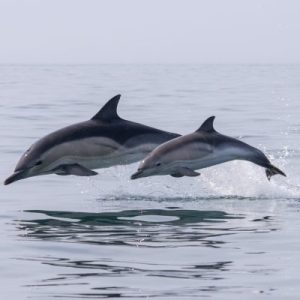This was the subject at Ferring Conservation Group’s September meeting, very well presented by James Milton of the Sussex Dolphin Project, based at Shoreham seafront. Their mission is to protect local dolphin species through research, awareness and education to restore and increase the population of these fascinating marine mammals. He began with some excellent video footage of Bottle-nosed dolphins following a boat from Newhaven, swimming and leaping into the air. James said dolphins and porpoises can be seen from the shore, all along the Sussex coast and often within 20 metres of the shore but the only way to see them at close quarters is from a boat, and the Trust arranges regular boat trips between May and October out to their favourite locations, including near the Rampion Windfarm.
mammals. He began with some excellent video footage of Bottle-nosed dolphins following a boat from Newhaven, swimming and leaping into the air. James said dolphins and porpoises can be seen from the shore, all along the Sussex coast and often within 20 metres of the shore but the only way to see them at close quarters is from a boat, and the Trust arranges regular boat trips between May and October out to their favourite locations, including near the Rampion Windfarm.
Dolphins and porpoises belong to the same group as whales, ‘the Cetaceans’ and he told us that the Orca, or ‘Killer Whale’ is really a dolphin species. Dolphins are much more common in our waters than porpoises, and the most common dolphin species is the ‘Bottle-nosed’. They are air-breathing mammals, taking in air when on the surface, or in their leaps, hold their breath while submerged and expelling it through a blow-hole in their head, just like whales. They eat Cod, Whiting and Pollack, and sometimes squid and crustaceans, finding their prey, by echo-location and communicating with each other by ‘clicking’ signals,
The only real threat to their survival is the ‘Super-trawler’, that can be up to 130 metres long, with gigantic nets, catching fish of all sizes and throwing the unwanted species, including dolphins – dying or badly injured, over the side, or selling them to be made into pet food. The Sussex Dolphin Project joins other conservation groups in pressing the Government to regulate super-trawlers more effectively – existing regulations are easy to evade.
We learned a great deal from this talk, including the different outlines of bottle-nosed dolphins and Harbour Porpoises, the only porpoise to be found off our coast. The Bottle-nose, and the sickle-shaped dorsal fin is very distinctive for our dolphins; our porpoises are smaller and stockier, have more rounded faces and a triangular fin, and they usually swim alone. After this talk Graham Tuppen gave an update on local wildlife sightings, Ed Miller on planning applications and appeals, and Pete Coe on the Group’s practical conservation projects.
